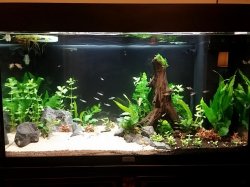Thanks Byron.
I'll put a timer in and do 6hrs a day.
I'll dose my Flourish as per the instructions then and keep an eye on the shrimps....
Provided you do not exceed the recommended dose levels, the copper in Flourish Comp is so minimal it will not harm invertebrates. The copper occurring in some tap water is more likely to cause issues even for fish, as the "safe" level for humans is higher than for fish.
You said my lights are a bit bright, I could get another 'Nature' light which is only about $5 so then its 2x 4100K lights.
StevenF has gone into this, but I will just briefly add that Kelvin (the 4100K) is the measurement unit for the colour temperature of light. The "warmer" the light, meaning more red and less blue, the lower the Kelvin rating, whereas the higher the K the less red and more blue creating "cooler" light. It has nothing to do with intensity, though the K is important.
Aquatic plants need red and blue light to drive photosynthesis. Studies have shown that adding green to this mix does benefit, even though it is not a major photosynthetic colour for aquatic plants. The "daylight" tubes with a Kelvin between 5000K and 7000K generally fit the bill here. My single tube tanks have 6500K tubes, while on my dual tube tanks I use one 6500K and one 5000K. The 5000K is a tad warmer (more red) and I personally find this nice. So if you want to replace the 8000K, find one with around 6500K. I wouldn't mess with the 4100K provided you have as the second tube one with more of the blue in it.
MY plant choices was actually from forums and websites which suggested these as 'beginner' plants.
I'll see what they do over the next couple of weeks and if the Bacopa melts more, I'll just remove it.
MY Kabomba is actually the one doing the best I think, at least its not dying but I'm most stumped by the melting Anubias Nana though.
I thought they were the hardiest plants.....grows in water or emersed.
Several issues in this. I'll start with the emersed/submersed growth of plants. Many of our popular aquarium plants are marsh or bog plants, that grow emersed (leaves above water but roots in very wet soil/sand) part or all of the year, but may also grow fully submersed for part of the year, or can do so permanently. Swords (
Echinodorus species, and the dwarf chain swords in
Helanthium), many crypts,
Anubias, Java Fern, and even some stem plants are such plants naturally. Fortunately, they take to fully submersed cultivation well, so they make good aquarium plants. Usually most will not flower unless grown emersed for roughly half the year, though
Anubias is an exception as it does sometimes flower submersed.
The
Cabomba is likely doing well, so far, due to the brighter light. I have moderate light, and I have tried this plant several times but after a couple months it just slowly falls apart, primarily due to the light, though undoubtedly nutrient issues factor in.
The
Anubias is a low-light plant as I mentioned previously, and thus requires less nutrients to balance. I have found that
Anubias and Java Fern do not do well in direct lighting, though this can manifest itself by first (usually) increased brush algae, then yellowing leaves. A shade from floating plants may help. But again, the issue of adjusting to a new environment from previously is also a factor in most plants. Your light may be different, as may the water parameters (GH and pH), or temperature, or nutrient availability...all this is part of the equation. One crucial concept of an aquarium that is generally not fully understood or recognized especially by new aquarists is the incredibly close relationship of fish and plants to the water; this relationship is by far more important than air to terrestrial plants and animals, because of the nature of the aquatic environment, so moving a fish or plant from one tank to another may have very significant consequences. I could write a whole article on this, so I'll move on.
Generally speaking, stem plants are faster growing so they will always need more light (intensity, not duration) and more nutrients that plants that grow slower. Floating plants are all fast growing, because they have adapted to being closer to more intense lighting (even in nature, light does not have to penetrate water to reach floating plants), plus they have the aerial advantage of taking in CO2 directly from air, which is about four times faster than assimilating CO2 from water. Liquid fertilization thus benefits floating plants, and stem plants too.
Sword plants are moderate to fast growing plants, but not as fast as the afore-mentioned. So these generally do well with less lighting (intensity again, not duration) than what stem plants need.
Light intensity matters. Light travels through air very fast, compared to water. Blue light penetrates water deeper (this is why the oceans appear blue, and high blue actinic lighting is needed for corals and marine tanks), but freshwater plants also need red light. But light weakens significantly as it penetrates water.
But the fish must be considered too. Forest fish, which covers nearly all the freshwater fish we keep in tropical aquaria, do not appreciate overhead lighting. Floating plants will always benefit fish, so i would recommend using them. All of my tanks have floating plants, most of them fairly thick too. The other benefit is this will somewhat reduce the light entering the tank, which can be a benefit with stronger lighting.
As a last thought...I mentioned "intensity not duration" a couple times above. Duration cannot make up for intensity issues. If the light is not strong enough to drive photosynthesis (which differs in every plant species), increasing the duration will not compensate but only cause algae.
Byron.




 /fotohobbist.com/blog/aquarium-lighting-for-planted-aquariums/#more-136
/fotohobbist.com/blog/aquarium-lighting-for-planted-aquariums/#more-136